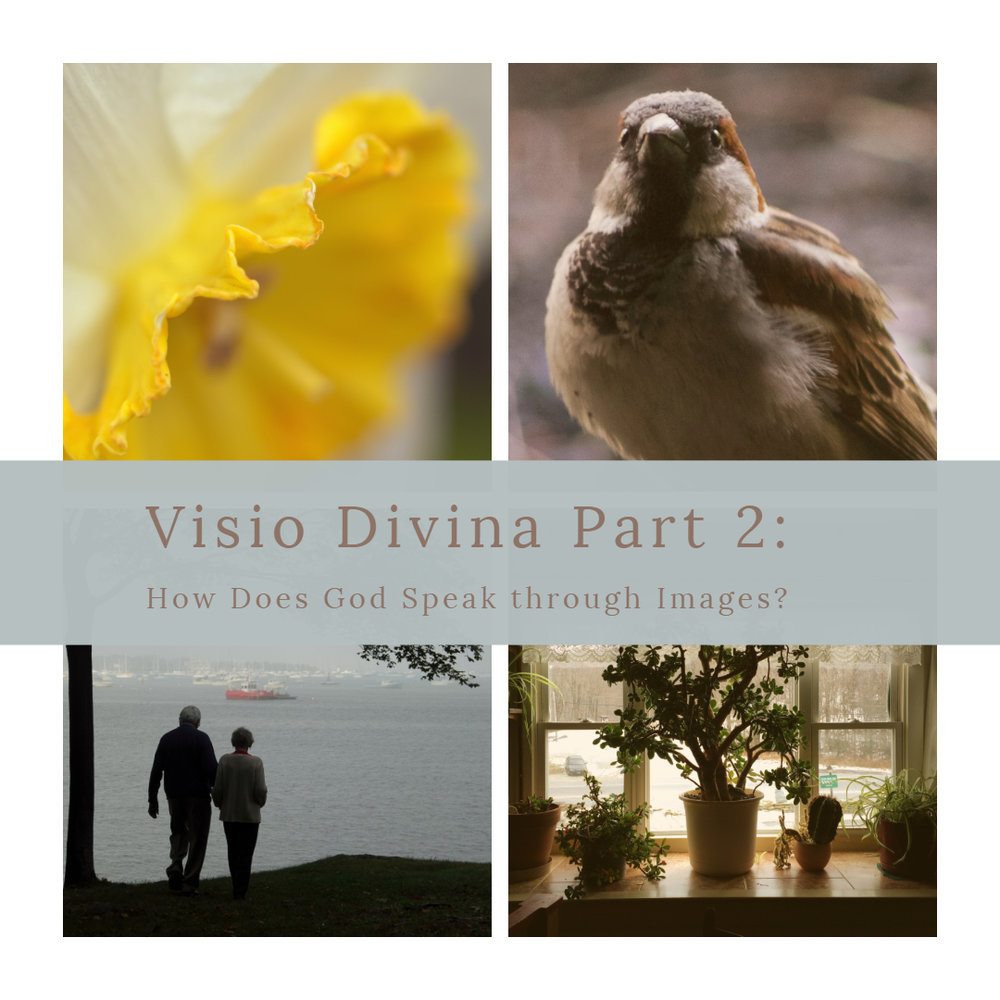Vision Divina Part 2: How Does God Speak through Images?
This part 2 in a 3-part series on Visio Divina. You can read part 1 here and part 3 here.
The ancient spiritual practice of visio divina was instrumental in the creation of Messages from God: An Illuminated Devotional and is a practice we incorporated into the companion workbook. Part one explained what the practice is all about. This part, part two, explores a bit about what it means to hear God as well as the role of metaphors and images as we sit in contemplation and prayer with an image before God. I am including many Scriptures in this section that I encourage you to look up and pray about as you explore this contemplative practice.

Hearing God
We all long to hear God’s voice. Some believe that God finished speaking what He had to say with the end of the Bible. I happen to not agree with that viewpoint. Throughout the Bible, God spoke to His people in a myriad of ways. And Scripture says that God is the same yesterday, today, and forever (Hebrews 13:8, James 1:17). So, why would God stop speaking? But also remember that He doesn’t contradict Himself (Hebrews 6:18, Numbers 23:19).
Preparing to Hear and Testing What You Hear
I strongly encourage you to check against Scripture anything you hear during your time with God and with the image you are praying with. If you are not sure, even after checking Scripture (1 Thessalonians 5:22, 2 Timothy 3:16, 1 John 4:1, Galatians 1:9), then speak to a pastoral person in your church.
One practice before you begin any contemplative practice is to pray Ephesians 1:18 (“I pray that the eyes of your heart may be enlightened in order that you may know the hope to which he has called you, the riches of his glorious inheritance in his holy people,”) Psalm 19:14 (“May the words of my mouth and the meditation of my heart be pleasing in your sight my Rock and my Redeemer.”) and John 16:13 (“But when he, the Spirit of truth, comes, he will guide you into all the truth. He will not speak on his own; he will speak only what he hears, and he will tell you what is yet to come.”). God is the hearer and answerer of our prayers.
When we hear God, it will often sound like words we’ve heard before, words from our own faith tradition but it is important that we listen beyond this as well as we learn more about God for ourselves. God is much bigger than our comprehension and the boxes we attempt to put Her into. (Notice what I did there?) Our faith journey is about knowing and loving God and growing into truth. It is knowing God’s love. We can do nothing to make Her love us. That’s impossible because She already loves us with a perfect love. (John 3:16)
“Our struggle in this life isn’t to make God love us. Our struggle is to make room in our lives to receive God’s love and to hear God speak.” -Ed Cyzewski in The Contemplative Writer
God’s Voice
“The Lord said, “Go out and stand on the mountain in the presence of the Lord, for the Lord is about to pass by.”
Then a great and powerful wind tore the mountains apart and shattered the rocks before the Lord, but the Lord was not in the wind. After the wind there was an earthquake, but the Lord was not in the earthquake. After the earthquake came a fire, but the Lord was not in the fire. And after the fire came a gentle whisper. When Elijah heard it, he pulled his cloak over his face and went out and stood at the mouth of the cave.
Then a voice said to him, “What are you doing here, Elijah?”
We all have certain expectations of what we think God’s voice will sound like. Even Elijah did. And the sound of His voice or the way in which He speaks may surprise us.
“Many times we miss His answer because we are looking for the audible voice of God or a lightning bolt to hit. But sometimes He speaks by putting peace in our hearts, by a still small voice within, by a sound outside, or by bringing a verse to our minds. Just let Him speak in creative ways; after all, He is the Creator of the universe and English isn’t the only language He speaks. Record what He says and follow His lead. Make sure that what you are hearing is biblical and that you are able to confide in others you trust about your journey.” – Theresa Dedmon in Born to Create
God meets us where we are and speaks to us in ways that we will understand. God knows our human limitations and our propensities and quirks since She created each one of us. She may speak to us through an impression or memory, through something someone says, through something that happens in the world outside of us. In Judges 6:36-40, God answered Gideon with a wet fleece… and then a dry fleece. See, God knows even our doubts. God longs to teach us and She longs for us to know the sound of Her voice (John 10:27). She longs to guide us, lead us, and teach us.
“And I know what a relief it is to hear the voice that calls us out of the place where we’re stuck and directs us to the truth that we can’t find on our own.” -Ginny Kubitz Moyer in Taste and See: Experiencing the Goodness of God with Our Five Senses
Yes, God can speak to us with all of our senses – sight, sound, taste, smell, and touch. These are all the ways that the body communicates with the mind and God can use any of them to speak to us. But sometimes that communication between God and us and us and God defies description as Madeleine L’Engle pointed out in Walking on Water: Reflections on Faith and Art:
“We need the prayers of words, yes; the words are the path to contemplation; but the deepest communion with God is beyond words, on the other side of silence.”
Images and Metaphors
Here’s a quick and simple exercise to display the role of images and metaphors in our faith. Go ahead and describe God. Seriously. Spend a couple of moments and either speak or write a few sentences describing God. I can almost guarantee that you have a couple of images and metaphors in there. Go ahead and check out a few Psalms or the Song of Solomon or Revelations. The Bible is FULL of images, metaphors, poetic language. Most of us haven’t actually seen God and likely won’t until we are face to face with Him in Heaven. So, how do you go about describing a God you haven’t seen? I love what Christine Valters Paintner has to say in Eyes of the Heart: Photography as a Christian Contemplative Practice:
“We speak about God in images. We are creatures who understand the world through our senses, so we make sense of things through images and sensual language. No one has ever seen God; even in the story of Moses, he catches only a glimpse of God’s backside. We feel God’s presence at work, but the language of metaphor points to a much larger reality… We get into trouble when we identify God solely with a narrow range of images, limiting God to only those possibilities…even when we exhaust every last image or idea of God we have, God is still much greater than all of that. God’s mystery is so much more expansive than anything we can try to contain through language or art.”
And Madeleine L’Engle, again from her book Walking on Water: Reflections on Faith and Art, points out that:
“Sign and symbol, sacrament and myth, metaphor and simile, are essential to all art, regardless of the personal belief or lack of belief of the artist.”
Howard Zehr in his book Little Book of Contemplative Photography: Seeing With Wonder, Respect And Humility talks about how metaphors are related to our knowing. Our awareness of metaphor will inevitably deepen our experience.
“All knowing – whether rational or intuitive – involves metaphors, and photographic images often have important metaphoric dimensions…Whenever we talk about things that we cannot see or touch, we inevitably do so by making a comparison to something that we can know more directly.”
God speaks to us through color, texture, shape, memory, impression, our five senses, inner peace, the outside world. God is always speaking. We need to continue to pray that we hear Him and see Him as He reveals Himself to us through art or any other way He chooses to reveal Himself. The contemplative practice of visio divina doesn’t have to stop with a photograph or painting or other piece of art. This awareness of God, this listening for His voice in our daily life, opens us to hear Him anywhere.
I once had a dream that I was stepping over a piece of trash on the ground and (in the dream) God whispered in my ear: “This is holy ground.” I woke with a bit of a startle. Yes, that took me aback a bit. However, after many hours contemplating the dream and reading scripture I feel like I understand what God was telling me. Wherever we are is holy ground because we carry within us the Holy Spirit and wherever God is present, that place is holy. God can speak to us in a junk yard as plainly as He can speak to us sitting in a pew at church. Nothing at all can separate us from God or God’s love – neither death nor life, neither angels nor principalities, neither the present nor the future, nor any powers, neither height nor depth, nor anything else in all creation (including a piece of trash!). Romans 8:38-39.
A Few More Scriptures to Guide You
Below is a list of scriptures that I encourage you to look up as you embark into this practice.
My Prayer for You
My prayer is that you will learn to hear the voice of God in all the ways He speaks as you go through your daily life. Visio Divina is one of many different spiritual practices that will help you to learn to slow down and really listen.
Join me next week in Part 3 as I share with you an example of visio divina with an image recently released to the public domain by The Met (Metropolitan Museum of Art in New York)
Originally posted March 28, 2019 on www.MessagesFromGodDevotional.com
